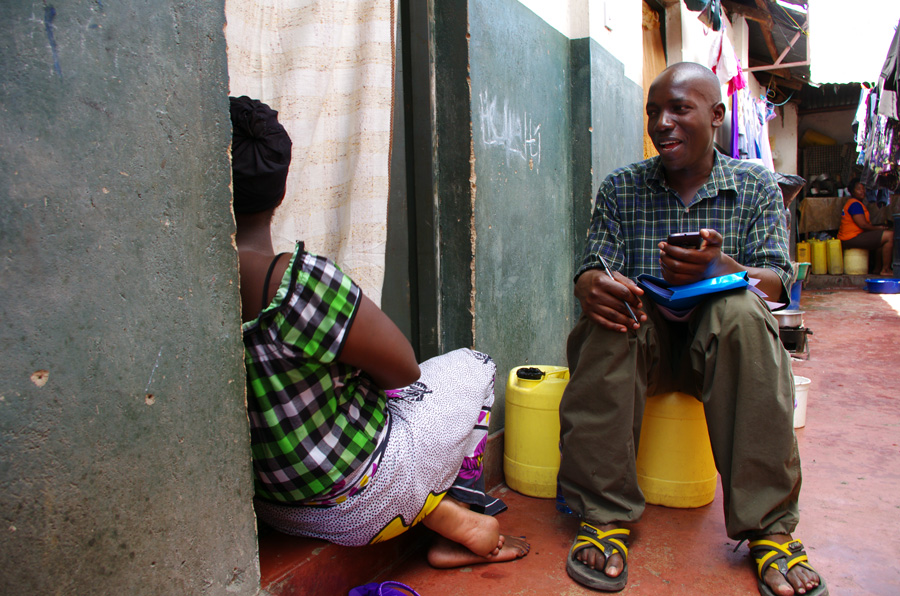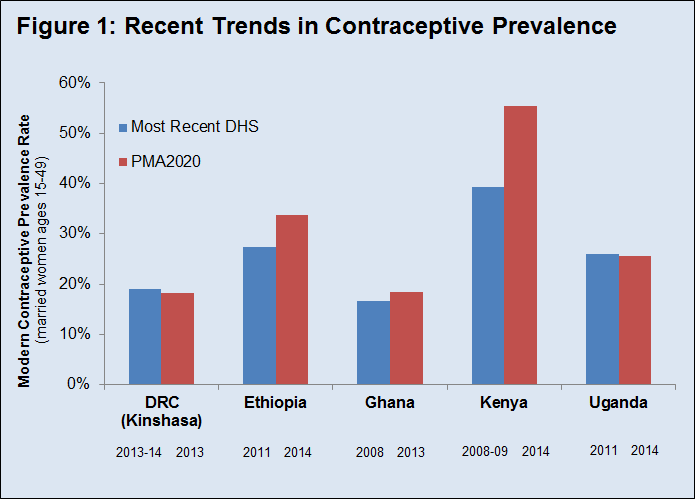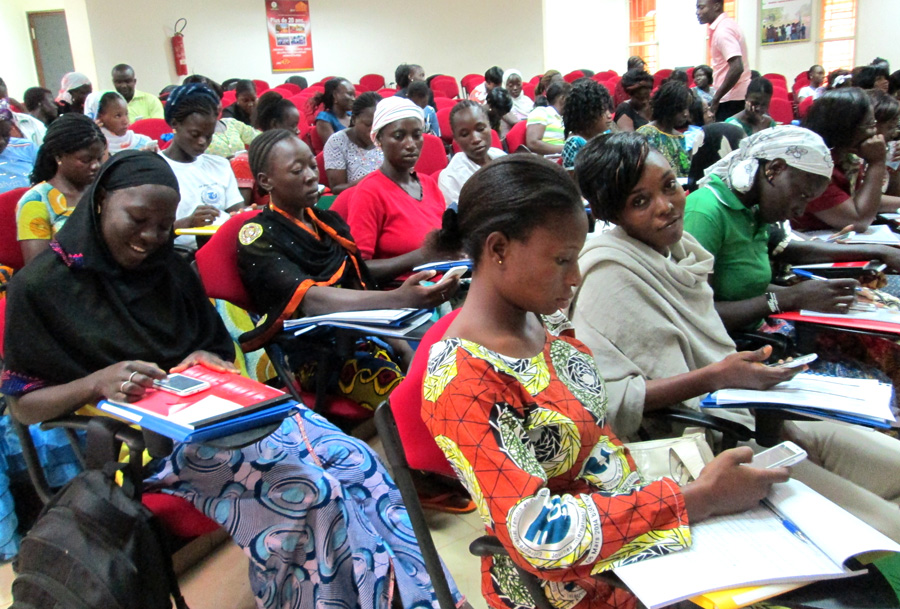-
Mobile Tech Drives Faster Data Collection for Family Planning Indicators With PMA2020
December 22, 2014 By Elizabeth Leahy MadsenIn an effort to revamp the time-intensive process of conducting household surveys to collect health data in developing countries, a new project is using mobile phones and rapid processing techniques to generate regular updates for a tranche of indicators previously only adjusted every three to five years.
Regular updates for a tranche of indicators previously only adjusted every three to five years
The Performance Monitoring and Accountability 2020 project (PMA2020) is supported by the Bill and Melinda Gates Foundation and conducts surveys in seven countries so far to estimate and track a number of development indicators at the household level. The surveys, updated every 6 to 12 months, focus on access to and use of family planning and water and sanitation data, with additional program areas and three countries to be added later.
Melinda Gates has described the project in vivid terms as an attempt to remedy limited and delayed information about family planning, which the Gates Foundation sees as a historically underinvested field. Data provided by the project is meant to inform Family Planning 2020 (FP2020), a global initiative that has captured the attention and resources of the foundation, other donors, and country governments with its unifying goal to expand family planning use to 120 million additional women in 69 countries by 2020.
Water and sanitation data has only been published for Ghana, but demographic and family planning data is now available for five countries, presenting a mixed picture of trends in sub-Saharan Africa (see Figure 1).
Harnessing the Mobile Revolution
To achieve the rapid turnaround they are looking for, PMA2020 is using a new form of data collection. The project is training local women in survey locations to administer questionnaires and equipping them with mobile phones so they can transmit the data gathered immediately. Along with a relatively short set of 50 questions, this tactic trims each survey timeline to 8 to 12 weeks from beginning data collection to obtaining results. It can also lead to fewer recording errors compared to paper forms, according to Scott Radloff, director of PMA2020.
Mobile phones transmit the data gathered immediately
This approach, referred to as the mobile-Assisted Data and Dissemination System (mADDS), is part of a wave of development efforts making use of mobile phones – which are nearly ubiquitous, even in the poorest regions – not only for data collection but health payments, community education, supply chain management, and clinical interventions for health providers and patients.
Most of PMA2020’s surveys are designed to be nationally representative. And although they are smaller in scope and sample size, the results are intended to align with those of the DHS Program (Demographic and Health Surveys), long the premier and most comprehensive source of family planning and other health data comparable across countries and time.
Kenya and Ethiopia Show Strongest Progress
The most surprising PMA2020 results to date have been in Kenya. Family planning use has surged, and the country’s stalled fertility transition of the 1990s and 2000s appears to be fully reversed.
The stalled fertility transition of the 1990s and 2000s appears to be fully reversed
PMA2020 reports that 55 percent of married women in Kenya use a modern contraceptive method, up from 39 percent in the 2008-09 DHS, and the total fertility rate fell from 4.6 to 3.5 children per woman. The growth in the contraceptive prevalence rate (CPR) represents an annual increase of 2.7 percentage points, almost five times faster than the increase between 1993 and 2003.
The results from Ethiopia, also demonstrating large increases in family planning use, were somewhat less surprising because they reinforce a clear trend demonstrated in recent DHS results. Although the PMA2020 survey was conducted only three years after the most recent DHS, the CPR for modern methods jumped by more than six percentage points to nearly 34 percent, or an annual increase of two points per year. During the same three-year period, the total fertility rate dropped from 4.8 to 4.3 children per woman, about the same rate of decline as in Kenya, which if maintained would put Ethiopia at nearly replacement level in just 12 years.
Change Slower in Ghana and Uganda
The project’s results from Ghana and Uganda, when used to gauge trends since the previous DHS, are less positive for family planning.
Over the five years between the 2008 Ghana DHS and the PMA2020 survey, modern CPR increased by less than two percentage points and remains quite low, at just over 18 percent among married women. The country’s fertility rate, historically much lower than many other countries with comparable contraceptive use, continued to decline, from 4.0 children per woman as measured by the DHS to 3.7 according to PMA2020.
Of the countries with at least a 3-year interval between surveys, Uganda is the only one with no increase
In Uganda, there was a three-year interval between the 2011 DHS and this year’s PMA2020 survey. Although PMA2020 found a slight decline in the fertility rate, from 6.2 to 5.9 children per woman, the modern CPR was unchanged at 26 percent among married women. Of the four countries with at least a three-year interval between DHS and PMA2020 surveys, Uganda is the only one with no increase in family planning use.
Direct Comparisons Possible in Kinshasa
PMA2020’s survey in the Democratic Republic of the Congo is unique in two ways. First, it is the only one to date for which a DHS was conducted simultaneously, allowing for direct comparison of results at the same point in time. Second, it is the only survey to date that was not nationally representative.
PMA2020’s data collection was limited to Kinshasa, the capital and largest city. The DHS was national but includes disaggregated results for Kinshasa province. Both surveys were conducted in late 2013 and early 2014 and found similar results. PMA2020 reported a slightly higher fertility rate (4.5 compared to 4.2 in the DHS) and the modern CPRs were nearly identical (18 compared to 19 percent among married women).
One FP2020 Commitment Already Achieved
In the wake of the 2012 London Summit that kicked off FP2020, several countries have made pledges related to increasing contraceptive prevalence. Based on the PMA2020 results, Kenya has achieved its goal of a total CPR of 56 percent by 2015 (Kenya has also committed to further expand use of contraception to 70 percent of married women by 2030).
Ethiopia’s extremely ambitious commitment to achieve a total CPR of 69 percent by 2015 is not likely to be achieved, based on PMA2020 results (34 percent), but its goal of reaching a total fertility rate of four children per woman is not far off (new estimate of 4.3).
Uganda’s FP2020 commitment is to reduce unmet need for family planning to 10 percent by 2022; PMA2020 results show no change from the level measured among married women in the 2011 DHS (34 percent).
Mobile Health Meets the Establishment
In addition to its mobile innovations, PMA2020’s approach contrasts in other ways with that of the DHS. Demographic and Health Surveys are typically implemented by national statistical agencies, planning ministries, or other government bodies, creating an inherent and deep ownership of the results within each country. PMA2020 surveys are implemented by local universities or other non-governmental partners, says Radloff. Although these are in-country institutions, and government stakeholders are briefed at each stage of the survey and have hosted some PMA2020 dissemination events, the less direct tie to the government may create a hurdle as the nascent project builds credibility.
Less direct ties to government may create a hurdle as the nascent project builds credibility
PMA2020 is an important part of the global FP2020 monitoring process, and has introduced new indicators of family planning choice, cost, and quality of care. At this early date, it remains to be seen how the new data will be integrated into planning and priorities for each country. Some national stakeholders familiar with and invested in the DHS may take a wait-and-see approach towards fully adopting and using PMA2020 data until it is clear whether they align with future DHS results.
Others, unfamiliar with PMA2020’s sampling methodology, may be unclear whether its results can be considered representative. The intentionally narrow samples of the Democratic Republic of Congo survey and forthcoming Nigeria and India surveys, which Radloff says will initially be limited to two states, could contribute to this uncertainty.
There has been only one opportunity to cross-check results between the two surveys so far, and the DHS and PMA2020 results for Kinshasa are quite similar. New DHS surveys are forthcoming in Ghana and Kenya, with preliminary results expected in early 2015. The wait will be longer in Ethiopia and Uganda. If the typical five-year interval is maintained, new DHS results are not likely to be available until 2017, by which time each country will have been through several additional rounds of PMA2020.
PMA2020’s intention to provide nearly real-time tracking of key family planning and health indicators is novel and valuable. The project’s objectives also include increasing partner-country capacity to use the data collected by monitoring and improving program performance and rapidly responding to changing needs within health systems.
As the project continues to gain awareness, with second rounds now getting underway, it will be important to emphasize partnerships across all sectors of partner countries and to clearly delineate how PMA2020 results compare to and complement those of the DHS and other established sources. The global health community’s push towards big data will be more effective and sustainable if integrated with existing structures and sources and the knowledge and trust they have accumulated.
Elizabeth Leahy Madsen is a consultant on political demography for the Wilson Center’s Environmental Change and Security Program and senior technical advisor at Futures Group.
Sources: The DHS Program, PMA2020.
Photo Credit: Fieldwork for PMA2020 in Mombasa, Kenya, and Ouagadougou, Burkina Faso, used with permission courtesy of PMA2020. Chart: Arranged by Elizabeth Leahy Madsen, data from PMA2020 and The DHS Program.
Topics: Africa, data, demography, development, DRC, Ethiopia, family planning, featured, gender, Ghana, global health, Kenya, mobile technology, Nigeria, U.S., Uganda
 A Publication of the Stimson Center.
A Publication of the Stimson Center.






